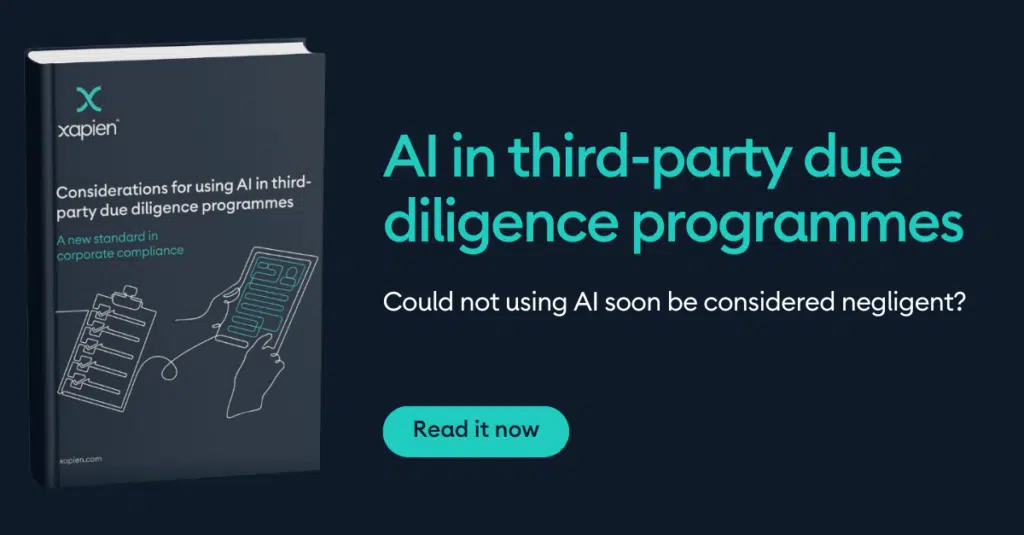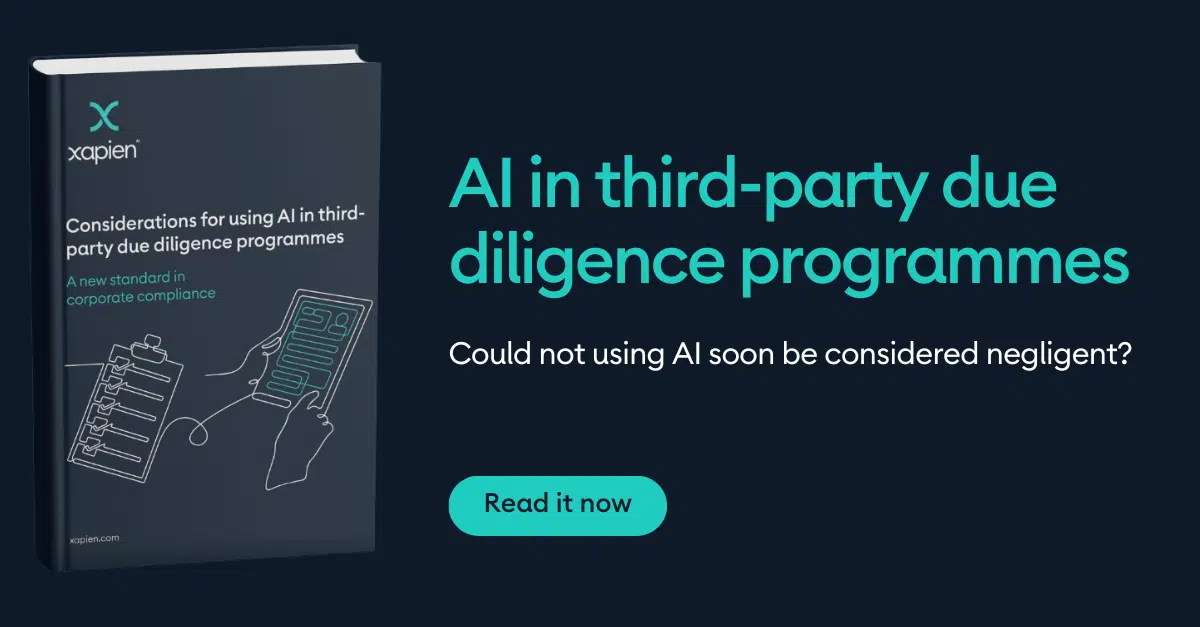
Third party due diligence:
5 important steps to an adverse media check

Compliance teams often rely on AML screening to build a risk profile. While this is an important first step, it provides only a partial view. Performing an adverse media check allows compliance teams to interpret this data within a broader context, using information from across the indexed internet to apply a truly risk-based approach.
However, the lack of clear regulatory guidance on screening third parties for negative news can make this step ambiguous. To do it effectively, compliance teams must go beyond structured databases and include publicly available sources such as news reports and high-profile documents like the Panama Papers.
Effective adverse media checks require knowing the scope of the search, identifying relevant information, filtering results, and using the findings appropriately. These five steps will help improve your adverse media checks and conduct a more comprehensive risk assessment.
Suggested reading: Reputational due diligence and how to conduct it has permanently shifted — read our blog Reputational Due Diligence to find out how.
1. Define the scope of your adverse media check
Defining the scope of your adverse media check is a crucial starting point. A clear scope ensures you capture all relevant risks while avoiding unnecessary noise. Without a well-defined scope, you risk either missing critical red flags or wasting time on irrelevant search results.
Each of these factors helps build a holistic risk profile. However, it’s important to prioritise them based on your risk appetite and regulatory requirements of your business. Defining the scope should also be based on the level of risk posed by the subject. For example, politically exposed persons (PEPs) or high-net-worth individuals may require deeper scrutiny of corruption, sanctions, and sources of wealth. On the other hand, routine third-party suppliers might need checks for legal disputes, financial crimes, or ESG risks.
2. Tailor your adverse media check to the subject
Tailoring your scope to the subject’s profile ensures a focused and effective search. For individuals like business owners and key executives, focus on personal history, political ties, and sources of wealth. Corporate entities such as third parties and suppliers, emphasise corporate governance, financial stability, and legal disputes. Similarly, for associated entities like subsidiaries and affiliates, it’s essential to consider their influence on the primary subject’s risk profile
Determine the geographic regions most relevant to the third party in question too. Focus on areas where the entity operates, has significant business dealings, or has ties to local authorities. Different regions pose varying levels of risk due to local regulations, political stability, corruption levels, and sanction policies. Companies operating in high-risk jurisdictions may require more stringent scrutiny for issues like bribery, sanctions violations, or human rights abuses.
3. Choose the right search strings
Using specific search strings that combine the subject’s name with targeted keywords such as ‘fraud,’ ‘money laundering,’ and ’embezzlement’ leads to more meaningful search results. This methodology not only helps surface relevant information but also enhances the accuracy of the findings. Precision in phrasing and filtering is crucial; even minor variations can significantly affect the search outcome.
Primary keywords: Begin with basic search terms that directly link to the individual or entity, such as the company name or the individual’s full name. This foundational step establishes a clear starting point for your research.
Negative terms: To refine your search further, combine primary keywords with relevant adverse terms. For example, include phrases such as:
- ‘Fraud’, ‘Bribery’, ‘Corruption’, ‘Money Laundering’, ‘Tax Evasion’
- ‘Sanctions’, ‘Terrorism’, ‘Organized Crime’, ‘Embezzlement’
- ‘Indictment’, ‘Lawsuit’, ‘Criminal Charges’, ‘Civil Penalties’
- ‘Bankruptcy’, ‘Insolvency’, ‘Bribe’, ‘Cartel’, ‘Scam’
Using these negative terms helps filter out unrelated results and zeroes in on potential risks associated with the subject. For example, a search string like “XYZ Corporation AND (fraud OR embezzlement) NOT bankruptcy” would help identify relevant issues while excluding unrelated financial problems.
Advanced search techniques: Incorporate Boolean operators (AND, OR, NOT) to enhance your search strings. For instance:
- Using “AND” between terms will return results that include all specified terms.
Example: “John Doe AND ‘money laundering'”
- Using “OR” allows for broader searches that include any of the specified terms.
Example: “John Doe AND (fraud OR embezzlement)”
- Using “NOT” excludes certain terms from your results.
Example: “John Doe AND ‘money laundering’ NOT ‘bankruptcy'”
These techniques allow for more nuanced searches, leading to better-quality results.
Local language terms: If the subject operates in regions with different languages, incorporating local language translations of key adverse terms is essential for a comprehensive search. This practice ensures that you capture relevant information that may not appear in English sources.
These keyword searches should be iterative. After reviewing initial results, researchers should refine their search strings based on what they find. This might involve adding new keywords, removing less relevant ones, or altering the structure of the search query.

3. Expand your range of sources
Incorporate the vast and growing range of publicly available data sources into their adverse media searches—negative media can appear across various platforms and formats. This includes national and international publications, financial journals, and industry-specific magazines.
Subscription databases such as LexisNexis and Dow Jones Risk & Compliance aggregate multiple media sources to offer access to historical articles, enabling thorough background checks and providing historical context for risk assessment.
Government and legal databases grant access to court cases, legal filings, sanctions lists, and enforcement action publications. These resources can provide critical insights into legal issues or regulatory compliance failures that may affect the subject.
Additionally, you can monitor prominent platforms such as LinkedIn and X (formerly Twitter) for public posts or discussions that could indicate reputational challenges. It’s worth noting that social media can provide real-time insights, but it does require careful evaluation to distinguish between credible information and unverified claims.
Online information can sometimes be hidden or deliberately false and misleading, so it’s easy to mistake online data for truth when it isn’t. As you incorporate more diverse data sources into due diligence, verify all information thoroughly. Failing to do so in this age of increased visibility can have disastrous consequences, especially in regulatory compliance cases.
4. Establish a reliable time range
When conducting adverse media checks, ensure that your search spans an appropriate time range, especially for high-risk subjects. Adverse media searches should generally cover a timeframe of at least 5 to 10 years of news history, depending on the context and nature of the subject. For example, individuals in high-profile roles may warrant a longer timeframe to capture their public history, while a smaller business may require a shorter span. Historical behaviour can be indicative of current risk levels; patterns of negative news can reveal long-standing issues that may still affect the subject today. However, while historical data is important, it is crucial to prioritise recent negative news, as findings from the past 1-2 years are often more indicative of ongoing or imminent risks.
5. Summarise findings into a report
This is where you turn fragmented findings into meaningful insights that drive decision-making. Summarising findings into a coherent report is crucial, as it helps stakeholders understand the insights and facilitates informed actions that can mitigate risks and leverage opportunities.
When choosing a report format, consider options like executive summaries for quick overviews, detailed analytical reports for in-depth insights, or dashboards for ongoing monitoring. Incorporating visuals—such as charts and graphs—can effectively convey complex data, making it easier for readers to grasp key insights at a glance.
It’s also essential to tailor the report to its intended audience. For instance, executives may prefer high-level summaries focusing on strategic implications, while compliance teams may require detailed information on specific risks and actions. Understanding the needs of your audience ensures that the report is relevant and actionable.
Deeper adverse media checks with Xapien
Adverse media checks are a critical component of due diligence. However, the growth of publicly available information is a significant challenge for researchers trying to keep up. An automated platform like Xapien is the only practical solution.
Xapien conducts real-time searches across the indexed internet to identify risks related to political exposure, sanctions, financial crimes, fraud, corruption, and legal disputes. It also assesses a subject’s source of wealth, business associates, career history, and exposure to environmental, social, and governance (ESG) risks. Researchers can generate reports on individuals, companies, and even legal entities for more narrow regulatory due diligence.
Typically, a single researcher conducts adverse media searches, which is time-consuming. Alternatively, companies outsource these searches to third-party consultancies, which can be costly. Many in-house researchers rely on adverse news databases that aren’t frequently updated, creating gaps in recent media coverage. Crafting specific search strings to capture all available information on the open web is also difficult and time-consuming. This process requires precision, which can lead to human error and it could still miss important information.
Xapien addresses these challenges by using Natural Language Processing (NLP) to rapidly search through online data. The platform can scan trillions of web pages in under 10 minutes, deriving critical insights from vast amounts of information based on simple context provided by the user, such as a subject’s name and a second piece of publicly available information, like a company name or an associated individual.
A disambiguation engine underpins Xapien’s search capabilities, ensuring that final reports are solely about the subject, which significantly reduces false positives. Xapien then summarises the findings into a fully sourced, digestible report that includes clear and concise sections on all identified risks and a chronological timeline of adverse media coverage. This allows researchers to focus not only on historical events but also on recent news that may be missed by curated news databases.
Watch Xapien’s powerful capabilities in action by booking a demo.

Monthly learnings and insights to your inbox
Xapien streamlines due diligence
Xapien's AI-powered research and due diligence tool goes faster than manual research and beyond traditional database checks. Fill in the form to the right to book in a 30 minute live demonstration.